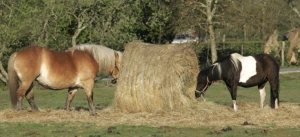 Put round bales of hay in a pasture with horses, and within a few days, much of the hay will have been dragged out of the bale and trampled into an ever-expanding circle. The remaining part of the bale will be showing moldy spots where it contacts the ground. As a result, some hay will have been eaten, but much will have been wasted.
Put round bales of hay in a pasture with horses, and within a few days, much of the hay will have been dragged out of the bale and trampled into an ever-expanding circle. The remaining part of the bale will be showing moldy spots where it contacts the ground. As a result, some hay will have been eaten, but much will have been wasted.
After evaluating this scenario, some horse owners have improved the situation by placing the round bale on an elevated gravel pad or wooden pallet, cutting down on mud; others placed the bale in a metal frame to keep horses from pawing out huge chunks of hay; and others gave up on round bales and fed hay in slow-feeder nets so that horses could nibble on it all day without wasting as much.
Several of these approaches can be combined by placing the round bale on a circular wooden pallet and covering the entire bale with a large slow-feeder net. A metal frame surrounds the bale and pallet to prevent pawing and entanglement. Horses can pick at the hay for hours, simulating the natural rate of forage ingestion. With little waste and no mold, a round bale lasts longer, saving money. More of the hay ends up inside the horses, with less trampled into the ground. Initial cost to set up such a system should be repaid as owners will need to purchase fewer round bales.
Do you have any questions about round bales? J and J Hay Farms can help! Contact us today.
Article brought to you by Kentucky Equine Research.
